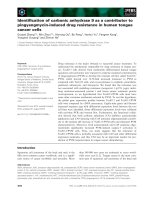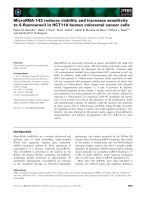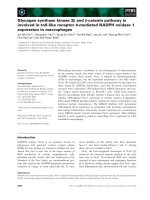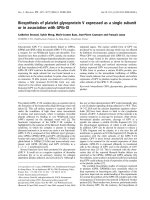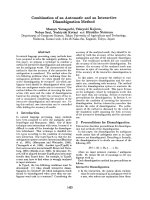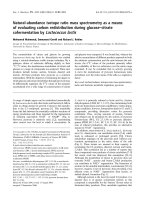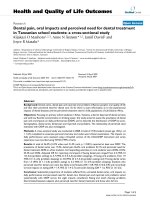Báo cáo khoa học: "Combination therapy with docetaxel and S-1 as a first-line treatment in patients with advanced or recurrent gastric cancer: a retrospective analysis" docx
Bạn đang xem bản rút gọn của tài liệu. Xem và tải ngay bản đầy đủ của tài liệu tại đây (518.53 KB, 7 trang )
WORLD JOURNAL OF
SURGICAL ONCOLOGY
Tanabe et al. World Journal of Surgical Oncology 2010, 8:40
/>Open Access
RESEARCH
BioMed Central
© 2010 Tanabe et al; licensee BioMed Central Ltd. This is an Open Access article distributed under the terms of the Creative Commons
Attribution License ( which permits unrestricted use, distribution, and reproduction in
any medium, provided the original work is properly cited.
Research
Combination therapy with docetaxel and S-1 as a
first-line treatment in patients with advanced or
recurrent gastric cancer: a retrospective analysis
Kazuaki Tanabe*
1
, Takahisa Suzuki
1
, Noriaki Tokumoto
1
, Hideki Yamamoto
1
, Kazuhiro Yoshida
2
and Hideki Ohdan
1
Abstract
Background: We performed a single-institution retrospective study to evaluate the efficacy and toxicities of
combination therapy with docetaxel and S-1 in patients with advanced or recurrent gastric cancer.
Methods: Eighty-six patients with advanced or recurrent gastric cancer were enrolled. Patients received docetaxel, 40
mg/m
2
, on day 1 and oral S-1, 80 mg/m
2
/day, on days 1 to 14 every 3 weeks.
Results: All 84 patients were assessable for response. The overall response rate was 52.4% (44/84) and the disease
control rate was 96.4% (81/84). Median time to progression (TTP) and overall survival (OS) were 6.5 (95% CI, 4.8-8.1
months) and 15.1 months (95% CI, 11.7-18.5 months), respectively. The major toxicities were neutropenia, leukopenia,
alopecia and anorexia. Grade 3 or 4 hematologic toxicities included neutropenia in 31 patients (36.0%), leukopenia in
27 (31.7%), febrile neutropenia in four (4.7%), and anemia in one (1.2%). Other grade 3 toxicities included anorexia in
five patients (5.8%), and stomatitis, diarrhea and nausea in one each (1.2%). There was one treatment-related death
(1.2%).
Conclusion: The combination of docetaxel and S-1 had good clinical activity with acceptable toxicity in patients with
advanced or recurrent gastric cancer.
Introduction
Worldwide, gastric cancer ranks second among causes of
all cancer-related deaths, with about 700,000 confirmed
mortalities annually [1]. In Japan, gastric cancer is still the
second most frequent cause of cancer-related death,
despite advances in diagnosis and treatment. For patients
with unresectable or recurrent gastric cancer, outcomes
are extremely poor, with a median survival time, if
untreated, of 3 to 5 months [2,3]. Many randomized con-
trolled trials of various treatment regimens have been
reported, including 5-fluorouracil, doxorubicin, and
mitomycin (FAM) [4], epirubicin and cisplatin (CDDP) in
combination with continuous infusion of 5-fluorouracil
(ECF) [5], and 5-fluorouracil and cisplatin (FP) [6], but all
produced median survivals of less than 1 year. No world-
wide standard regimen has as yet been established.
Recently, two randomized controlled trials were
reported from Japan [7,8]. One was the JCOG9912 trial,
which showed S-1 to be non-inferior to continuous infu-
sion of 5-fluorouracil with respect to overall survival
(OS). Another was the SPIRITS trial, which revealed S-1
plus CDDP to be superior to S-1 alone with respect to
OS. In clinical practice, S-1 plus CDDP has been recog-
nized as the standard chemotherapy regimen for
advanced or recurrent gastric cancer in Japan.
Docetaxel has shown promising activity in gastric can-
cer, both as monotherapy [9] and in combination with
other agents [10-12]. We performed phase I and phase II
studies of combination therapy with docetaxel and S-1
for patients with advanced or recurrent gastric cancer
[13,14]. In the phase II study, the overall response rate
was 56.3% (95% CI, 38-66%) and median survival time
was 14.3 months (95% CI, 10.7-20.3 months). The most
common severe toxicities were neutropenia (58.3%), leu-
kopenia (41.7%), anorexia (14.6%) and stomatitis (8.3%).
These findings suggested the regimen combining doc-
etaxel with S-1 to be a promising first line therapy for
* Correspondence:
1
Department of Surgery, Division of Frontier Medical Science, Graduate School
of Biomedical Science, Hiroshima University, Hiroshima, Japan
Full list of author information is available at the end of the article
Tanabe et al. World Journal of Surgical Oncology 2010, 8:40
/>Page 2 of 7
advanced or recurrent gastric cancer. On the basis of this
assumption, the objectives of the current study were to
retrospectively clarify the efficacy and toxicities of the
docetaxel and S-1 combination as a first-line treatment
for patients with advanced or recurrent gastric cancer
and to analyze prognostic factors in these patients.
Patients and methods
Patients
The subjects of this study were 86 patients treated
between August 2001 and September 2009 at the Hiro-
shima University Hospital. Patients were eligible for this
study if they had histologically confirmed advanced or
recurrent gastric cancer, no prior therapy, including adju-
vant therapy, Eastern Cooperative Oncology Group
(ECOG) performance status <3, age м20 years, adequate
organ function, and life expectancy of 3 months or more.
Written informed consent was obtained from all patients
prior to enrollment in the study according to institutional
guidelines.
Treatment regimen
S-1, at 80 mg/m
2
, was orally administered twice daily for
2 weeks, followed by a drug-free interval of 1 week (one
cycle). The docetaxel infusion was started simultaneously
with S-1 administration. Dexamethasone, 8 mg, was
infused 1 hour before docetaxel administration. The dose
of S-1 was reduced by 25% up to 50 mg/m2 in the event of
any of the following toxicities during the previous treat-
ment cycle: grade 4 leukopenia or neutropenia; thrombo-
cytopenia мgrade 3; and nonhematologic toxicity мgrade
3 except anorexia, nausea, and vomiting. There were no
dose reductions for docetaxel. Treatment with both S-1
and docetaxel was delayed for up to 3 weeks if patients
had insufficient hepatic, cardiac, renal, or bone marrow
function. (i.e., WBC <3,000/mm3, neutrophils <1,500/
mm3, platelets <100,000/mm3, fever <38°C with grade 3
to 4 neutropenia, or nonhematologic toxicity мgrade 3)
Cycles were repeated every 3 weeks, and the treatment
was continued until disease progression, unacceptable
toxicity, or the patient refused further therapy.
Evaluation of efficacy and toxicities
Responses were classified according to Response Evalua-
tion Criteria In Solid Tumors (RECIST) guidelines [15].
Tumor size was measured by CT scan with a 5 mm slice
thickness for all measurable lesions to assess responses
every 4 to 6 weeks. Toxicity was graded according to
Common Terminology Criteria for Adverse Events
(CTCAE) version 3.0 [16].
Statistical methods
OS was calculated from the date of chemotherapy initia-
tion to the date of all-cause death or the latest follow-up.
Time to progression (TTP) was calculated from the date
of chemotherapy to the first day of disease progression.
The median OS and TTP were estimated using the
Kaplan-Meier method. Multivariate analysis of prognos-
tic factors was performed by the Cox proportional hazard
method to evaluate the influences of prognostic factors
on patient survival. A P < 0.05 was considered to indicate
a statistically significant difference.
Results
Patient characteristics
The characteristics of our patients are summarized in
Table 1. Two patients were not evaluable for response;
one patient had a treatment-unrelated early death, and
the other refused the treatment for reasons not related to
toxicity during the course of the 2nd cycle. Treatment
administration of S-1 was delayed in 35 out of 633 cycles
patients (range, 7-16 days) because of grade 3 or 4 neu-
tropenia. No docetaxel doses were omitted. The median
age was 63 years (range, 25-81), and 84 (93.0%) patients
had good performance status (ECOG, 0 or 1). Seventy-
one patients (82.6%) had advanced stage disease at diag-
nosis and 15 (17.4%) experienced relapse after curative
surgery. A prior gastrectomy had been performed in 21
(24.4%) patients. The common major metastatic sites
were lymph nodes (52.3%), the peritoneum (37.2%), and
the liver (25.6%).
Tumor response and survival
Eighty-two patients were available for the response evalu-
ation. There were no patients showing complete
response, 44 (52.4%) patients showing partial response
(PR), 37 patients (44.0%) with stable disease (SD), and
three (3.5%) who showed disease progression (PD) (Table
2). The overall response rate was 52.4% (95% confidence
interval (CI), 42.9-64.5%). Fifty-two patients (60.5%)
received second-line chemotherapy after failure of this
regimen, including weekly paclitaxel and irinotecan plus
cisplatin. At a median follow-up of 12.7 months, the
median TTP was 6.5 months (95% CI, 4.8-8.1 months)
(Fig. 1a), and the median OS was 15.1 months (95% CI,
11.7-18.5 months) (Fig. 1b).
Toxi citi es
In total, 633 cycles were administered. The median num-
ber of cycles administered per patient was six (range, 2-
23). The toxicity profiles are summarized in Table 3. As to
hematological toxicities, Grade 3 or 4 neutropenia was
observed in 31 (36.0%) patients, leucopenia in 27 (31.7%)
and anemia in one (1.2%). Grade 3 febrile neutropenia
occurred in four (4.7%) patients. As to non-hematological
toxicities, Grade 3 anorexia was observed in five (5.8)
patients, and stomatitis, diarrhea, and nausea in one each
(1.2%). Docetaxel and S-1 dosage reductions were neces-
Tanabe et al. World Journal of Surgical Oncology 2010, 8:40
/>Page 3 of 7
sary in 17 patients, because of Grade 4 neutropenia in 16
(18.6%) and Grade 3 diarrhea in one (1.2%). There was
one treatment-related death (1.2%) in a patient who had
sepsis. Grade 4 neutropenia was obserbed in this patient
in the third cycle. The treatment of S-1 was discontinued
while granulocyte colony-stimulating factor (G-CSF) and
antibiotics were given. Despite intensive therapy, he died
due to pneumonia progressed rapidly to sepsis.
Prognostic factors
The results of univariate analyses of various patient and
tumor variables are shown in Table 4. The estimated OS
was significantly better for patients with good perfor-
mance status, tumor response and second-line chemo-
therapy. In the Cox proportional hazard model, the only
independent prognostic factor for OS was the tumor
response (Table 5). Patients with partial response had sig-
nificantly increased OS (Hazard ratio, 0.002 95% CI,
0.253-0.732; P = 0.002).
Discussion
A variety of treatment regimens have been developed [4-
6] and have improved the survival of patients with
advanced or recurrent gastric cancer. Currently, combi-
nation chemotherapy is considered to be more effective
than single-agent therapy. S-1 is an oral antitumor drug
that is composed of tegafur, 5-chloro-2,4 dihydroxypy-
rimidine and potassium oxonate. This drug was designed
to enhance the efficacy and reduce the gastrointestinal
toxicity of tegafur, a pro-drug of fluorouracil [17-19]. S-1
mono-therapy reportedly achieved a response rate of 45%
and 2-year survival rate of 17% [18,20]. In the SPIRITS
trial [8], the combination of S-1 and CDDP showed
encouraging results as compared to S-1 alone, with
response rates of 54% to 31% and OS of 13 months to 11
months. However, the results of the GC0301/TOP 002 (S-
1 vs S-1 + CPT-11) revealed that OS with combination
therapy did not significantly exceed that with mono-ther-
apy [21]. Other agents for use in combination with S-1,
such as taxans, should also be evaluated.
Table 1: Patient characteristics.
Characteristics No. of patients (%)
Total no.
Assemble for response 84
a
(97.7)
Assemble for toxicity 86
Gender
Male 58 (67.4)
Female 28 (32.6)
Age (years)
Median 60 (80.2)
Range 25-81
Performance status by ECOG
0 69 (80.2)
1 11 (12.8)
25 (5.8)
31 (1.2)
Disease status
Advanced 71 (82.6)
Recurrent 15 (17.4)
Prior gastrectomy
- 65 (75.6)
+ 21 (24.4)
Metastatic site
Liver 22 (25.6)
Lymph node 45 (52.3)
Peritoneum 32 (37.2)
Bone 3 (3.5)
Lung 2 (2.3)
Ovary 2 (2.3)
No. of organs involved
1 63 (73.3)
2 21 (24.4)
32 (2.3)
a
Two parients were not evaluable.
Table 2: Response assessment.
No. of patients %
Complete response 0 0
Partial response 44 52.4
Stable disease 37 44.0
Progressive disease 3 3.6
The overall response rate was 52.4% (95% confidence interval, 42.9-64.5)
Tanabe et al. World Journal of Surgical Oncology 2010, 8:40
/>Page 4 of 7
Figure 1 The time to progression (A) and overall survival (B).
Tanabe et al. World Journal of Surgical Oncology 2010, 8:40
/>Page 5 of 7
The main rationales for combination treatment with
docetaxel and S-1 were synergistic antitumor activity in
vivo and lack of overlapping toxicities [22]. We previously
demonstrated the mechanisms underlying the synergistic
effects of docetaxel with S-1 [23]. The expressions of thy-
midylate synthase and dihidropyrimidine dehydrogenase
were decreased and that of orotate phosphorybosyl trans-
ferase was increased when docetaxel was administered in
combination with S-1. In addition, in recent retrospective
and phase I/II study [13,14,24], the combination therapy
demonstrated promising results for highly activity and
manageable toxicity as first-line regimen for advanced or
recurrent gastric cancer.
In this study, combination therapy with docetaxel and
S-1 showed good clinical activity with acceptable toxicity
in patients with advanced or recurrent gastric cancer. The
overall response rate was 52.4%, median TTP 6.5 months,
and median OS 15.1 months. The major toxicities were
leucopenia (52.3%), alopecia (46.5%), neutropenia (45.3%)
and anorexia (41.8%), respectively. Grade 3 or 4 hemato-
logic toxicities included neutropenia (36.0%), leucopenia
(31.7%), febrile neutropenia (4.7%) and anemia (1.2%),
which occurred in 55.6% (40/72) within three cycles.
However, the hematological and non-hematological tox-
icities were both tolerable, except in one case which died
due to Grade 4 neutropenia followed by sepsis, and most
subjects could be treated as outpatients. This present
results were compatible with those of a previously
reported Phase I/II study. Herein, we also found the
tumor response to be a prognostic factor indicating
increased OS, while other independent factors, such as
performance status, disease status and histology meta-
static sites, did not affect survival. Second-line chemo-
therapy also didn't contribute to the favorable OS in this
study. There is no established second-line chemotherapy
for gastric cancer, but some randomized phase II or III
study are now ongoing, such as JACCRO GC-05: the
romdomized phase II/III study comparing CPT-11
monotherapy with the S-1/CPT-11 combination for S-1
refractaory gastric cancer. Based on these promising
results, a phase III study (JACCRO GC03 study) [25]
comparing S-1 alone versus the combination of docetaxel
and S-1 has been launched. This is a prospective, multi-
center, multinational, randomized study of patients with
advanced gastric cancer. The primary objective of the
study is to compare median OS with the combination
therapy (docetaxel and S-1) to that in the control arm (S-
1 alone). In total, 638 patients were enrolled (the original
Table 3: Hematologic and non-hematologic toxicities
Grade of toxicities % of Grade
Toxicity 12343 or 4
Hematologic
toxicities
Leukopenia 8 (9.3) 10 (11.6) 25 (29.1) 2 (2.3) 31.4
Neutropenia 3 (3.5) 5 (5.8) 15 (17.4) 16 (18.6) 36.0
Anemia 8 (9.3) 1 (1.2) 1 (1.2) - 1.2
Thrombocyt
openia
5 (5.8)
Febrile
neutropenia
4 (4.7)-4.7
Non-hematologic
toxicities
Alopecia 27 (31.4) 13 (15.1) - - -
Anorexia 24 (27.9) 7 (8.1) 5 (5.8) - 5.8
Diarrhea 8 (9.3) 3 (3.5) 1 (1.2) - 1.2
Dysgeusia 6 (7.0) - - - -
Hyperpigme
ntation
12 (14.0) - - - -
Infection - - - 1 (1.2) 1.2
Nausea 10 (11.6) 1 (1.2) 1 (1.2) - 1.2
Stomatitis 14 (16.3) 2 (2.3) 1 (1.2) - 1.2
Grading according to CTCAE (version 3.0)
Tanabe et al. World Journal of Surgical Oncology 2010, 8:40
/>Page 6 of 7
goal was 628 patients, 314 in each treatment arm), and
the final results will be reported in 2010. Depending on
the results of the GC03 study, this combination regimen
may become a first-line standard therapy for patients
with advanced or recurrent gastric cancer.
In conclusion, our retrospective study demonstrated
that the docetaxel and S-1 combination has good clinical
activity with acceptable toxicity when administered as a
first-line treatment for patients with advanced or recur-
rent gastric cancer.
Table 4: Prognostic factor analysis (univariate).
OS (months) 95% CI P value
Age
< median 15.2 11.5 - 19.0 0.491
м median 12.8 7.1 - 18.4
Gender
male 13.2 9.8 - 14.8 0.49
Female 16.8 10.7 - 22.8
Performance status
0-1 15.2 12.0 18.5 0.01
м 2 7.6 0 - 16.5
Disease status
Advanced 15.2 11.7 - 18.8 0.24
Recurrent 12.1 9.1 - 15.1
Histology
differentiated 14.5 9.1 - 18.2 0.357
undifferentiated 14.6 11.0 - 18.2
No. of organs involved
1 12.8 10.1 - 15.4 0.414
м 2 16.9 14.4 - 19.3
Liver metastasis
No 16.0 12.7 - 19.3 0.237
Yes 10.4 3.5 - 17.3
Peritoneum metastasis
No 15.1 9.5 - 20.7 0.54
Yes 14.6 11.1 - 18.1
Tumor response
No (SD or PD) 8.6 6.0 - 11.2 <0.001
Yes (PR) 18.2 12.7 - 23.7
Second-line chemotherapy
No 8.6 4.2 - 13.0 0.024
Yes 16.3 15.0 - 17.5
OS, median overall survival
Table 5: Multivariate analyss of overall survival.
P value Hazard ratio 95% CI
Performance status 0.1 2.098 0.867 - 5.073
Tumor response 0.002 0.43 0.253 - 0.732
Second-line chemotherapy 0.573 0.855 0.495 - 1.476
Tanabe et al. World Journal of Surgical Oncology 2010, 8:40
/>Page 7 of 7
Competing interests
The authors declare that they have no competing interests.
Authors' contributions
KT carried out the studies. TS, NT, and HY participated in its design and coordi-
nation and helped to draft the manuscript. KY conceived of the study and par-
ticipated in its design and coordination. HO, chief of our institution helped to
draft the manuscript and revised it critically. All authors read and approved the
financial manuscript.
Author Details
1
Department of Surgery, Division of Frontier Medical Science, Graduate School
of Biomedical Science, Hiroshima University, Hiroshima, Japan and
2
Department of Surgical Oncology, Graduate School of Medicine, Gifu
University, Gifu, Japan
References
1. Kamangar F, Dores GM, Anderson WF: Patterns of cancer incidence,
mortality, and prevalence across five continents: Defining priorities to
reduce cancer disparities in different geographic regions of the world.
J Clin Oncol 2006, 24:2137-2150.
2. Murad AM, Santiago FF, Petroianu A, Rocha PRS, Rodrigues MAG, Rausch
M: modified therapy with 5-fluorouracil, doxorubicin, and
methotrexate in advanced gastric-cancer. Cancer 1993, 72:37-41.
3. Pyrhonen S, Kuitunen T, Nyandoto P, Kouri M: Randomised comparison
of fluorouracil, epidoxorubicin and methotrexate (FEMTX) plus
supportive care with supportive care alone in patients with non-
resectable gastric cancer. Br J Cancer 1995, 71:587-591.
4. Macdonald JS, Schein PS, Woolley PV, Smythe T, Ueno W, Hoth D, Smith F,
Boiron M, Gisselbrecht C, Brunet R, Lagarde C: 5-Fluorouracil,
doxorubicin, and mitomycin (FAM) combination chemotherapy for
advanced gastric cancer. Ann Intern Med 1980, 93:533-536.
5. Findlay M, Cunningham D, Norman A, Mansi J, Nicolson M, Hickish T,
Nicolson V, Nash A, Sacks N, Ford H, Carter R, Hill A: A phase II study in
advanced gastro-esophageal cancer using epirubicin and cisplatin in
combination with continuous infusion 5-fluorouracil (ECF). Ann Oncol
1994, 5:609-616.
6. Ohtsu A, Shimada Y, Shirao K, Boku N, Hyodo I, Saito H, Yamamichi N,
Miyata Y, Ikeda N, Yamamoto S, Fukuda H, Yoshida S, Japan Clinical
Oncology Group Study (JCOG9205): Randomized phase III trial of
fluorouracil alone versus fluorouracil plus cisplatin versus uracil and
tegafur plus mitomycin in patients with unresectable, advanced
gastric cancer: The Japan Clinical Oncology Group Study (JCOG9205).
J Clin Oncol 2003, 21:54-59.
7. Boku N, Yamamoto S, Fukuda H, Shirao K, Doi T, Sawaki A, Koizumi W, Saito
H, Yamaguchi K, Takiuchi H, Nasu J, Ohtsu A, Gastrointestinal Oncology
Study Group of the Japan Clinical Oncology Group: Fluorouracil versus
combination of irinotecan plus cisplatin versus S-1 in metastatic
gastric cancer: a randomised phase 3 study. Lancet Oncology 2009,
10:1063-1069.
8. Koizumi W, Narahara H, Hara T, Takagane A, Akiya T, Takagi M, Miyashita K,
Nishizaki T, Kobayashi O, Takiyama W, Toh Y, Nagaie T, Takagi S, Yamamura
Y, Yanaoka K, Orita H, Takeuchi M: S-1 plus cisplatin versus S-1 alone for
first-line treatment of advanced gastric cancer (SPIRITS trial): a phase III
trial. Lancet Oncology 2008, 9:215-221.
9. Einzig AI, Neuberg D, Remick SC, Karp DD, Odwyer PJ, Stewart JA, Benson
AB: Phase II trial of docetaxel (Taxotere) in patients with
adenocarcinoma of the upper gastrointestinal tract previously
untreated with cytotoxic chemotherapy: The eastern cooperative
oncology group (ECOG) results of protocol E1293. Med Oncol 1996,
13:87-93.
10. Thuss-Patience PC, Kretzschmar A, Reichardt P: Docetaxel in the
treatment of gastric cancer. Future Oncol 2006, 2:603-620.
11. Fushida S, Fujimura T, Oyama K, Yagi Y, Kinoshita J, Ohta T: Feasibility and
efficacy of preoperative chemotherapy with docetaxel, cisplatin and S-
1 in gastric cancer patients with para-aortic lymph node metastases.
Anticancer Drugs 2009, 20:752-756.
12. Zang DY, Yang DH, Kim MJ, Jang KM, Hwang SW, Yoo KS, Han T, Kim HY,
Kim HJ, Kwon JH, Song HH, Park S, Jung JY, Kim HS, Kim JH: Dose-finding
study of docetaxel, oxaliplatin, and S-1 for patients with advanced
gastric cancer. Cancer Chemother Pharmacol 2009, 64:877-883.
13. Yoshida K, Hirabayashi N, Takiyama W, Ninomiya M, Takakura N, Sakamoto
J, Nishiyama M, Toge T: Phase I study of combination therapy with S-1
and docetaxel (TXT) for advanced or recurrent gastric cancer.
Anticancer Res 2004, 24:1843-1851.
14. Yoshida K, Ninomiya M, Takakura N, Hirabayashi N, Takiyama W, Sato Y,
Todo S, Terashima M, Gotoh M, Sakamoto J, Nishiyama M: Phase II study
of docetaxel and S-1 combination therapy for advanced or recurrent
gastric cancer. Clin Cancer Res 2006, 12:3402-3407.
15. Eisenhauer EA, Therasse P, Bogaerts J, Schwartz LH, Sargent D, Ford R,
Dancey J, Arbuck S, Gwyther S, Mooney M, Rubinstein L, Shankar L, Dodd
L, Kaplan R, Lacombe D, Verweij J: New response evaluation criteria in
solid tumours: Revised RECIST guideline (version 1.1). Eur J Cancer
2009, 45:228-247.
16. Trotti A, Colevas AD, Setser A, Rusch V, Jaques D, Budach V, Langer C,
Murphy B, Cumberlin R, Coleman CN, Rubin P: CTCAE v3.0: development
of a comprehensive grading system for the adverse effects of cancer
treatment. Semin Radiat Oncol 2003, 13:176-181.
17. Shirasaka T, Nakano K, Takechi T, Satake H, Uchida J, Fujioka A, Saito H,
Okabe H, Oyama K, Takeda S, Unemi N, Fukushima M: Antitumor activity
of 1 M tegafur-0.4 M 5-chloro-2,4-dihydroxypyridine-1 M potassium
oxonate (S-1) against human colon carcinoma orthotopically
implanted into nude rats. Cancer Res 1996, 56:2602-2606.
18. Koizumi W, Kurihara M, Nakano S, Hasegawa K: Phase II study of S-1, a
novel oral derivative of 5-fluorouracil, in advanced gastric cancer. For
the S-1 Cooperative Gastric Cancer Study Group. Oncology 2000,
58:191-197.
19. Fukushima M, Satake H, Uchida J, Shimamoto Y, Kato T, Takechi T, Okabe
H, Fujioka A, Nakano K, Ohshimo H, Takeda S, Shirasaka T: Preclinical
antitumor efficacy of S-1: a new oral formulation of 5-fluorouracil on
human tumor xenografts. Int J Oncol 1998, 13:693-698.
20. Sakata Y, Ohtsu A, Horikoshi N, Sugimachi K, Mitachi Y, Taguchi T: Late
phase II study of novel oral fluoropyrimidine anticancer drug S-1 (1 M
tegafur-0.4 M gimestat-1 M otastat potassium) in advanced gastric
cancer patients. Eur J Cancer 1998, 34:1715-1720.
21. Imamura H, Iishi H, Tsuburaya A, Hatake K, Imamoto HME: Randomized
phase III study of irinotecan plus S-1 (IRIS) versus S-1 alone as first-line
treatment for advanced gastric cancer (GC0301/TOP-002).
Gastrointestinal Cancer Symposium 2008. Abstract #5:Orland, USA.
22. Neste E Van Den, de Valeriola D, Kerger J, Bleiberg H, Kusenda Z, Brassinne
C, Bartholomeus S, Selleslags J, Hennebert P, Wythouck H, Cazenave I,
Lefresne-Soulas F, Piccart M: A phase I and pharmacokinetic study of
docetaxel administered in combination with continuous intravenous
infusion of 5-fluorouracil in patients with advanced solid tumors. Clin
Cancer Res 2000, 6:64-71.
23. Wada Y, Yoshida K, Suzuki T, Mizuiri H, Konishi K, Ukon K, Tanabe K, Sakata
Y, Fukushima M: Synergistic effects of docetaxel and S-1 by modulating
the expression of metabolic enzymes of 5-fluorouracil in human
gastric cancer cell lines. Int J Cancer 2006, 119:783-791.
24. Tsutani Y, Ohara M, Suzuki T, Minami K, Miyahara E, Kameda A, Noso Y:
Docetaxel and S-1 as a First-line Treatment in Patients with Advanced
or Recurrent Gastric Cancer. Anticancer Res 2009, 29:2775-2779.
25. Fujii M: Chemotherapy for advanced gastric cancer: ongoing phase III
study of S-1 alone versus S-1 and docetaxel combination (JACCRO
GC03 study). International Journal of Clinical Oncology 2008, 13:201-205.
doi: 10.1186/1477-7819-8-40
Cite this article as: Tanabe et al., Combination therapy with docetaxel and S-
1 as a first-line treatment in patients with advanced or recurrent gastric can-
cer: a retrospective analysis World Journal of Surgical Oncology 2010, 8:40
Received: 2 March 2010 Accepted: 19 May 2010
Published: 19 May 2010
This article is available from: 2010 Tanabe et al; licensee BioMed Cen tral Ltd. This is an Open Access article distributed under the terms of the Creative Commons Attribution License ( ), which permits unrestricted use, distribution, and reproduction in any medium, provided the original work is properly cited.World Journal of Surgical Oncology 2010, 8:40

